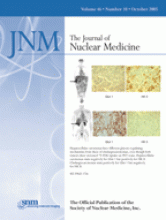Abstract
Patients with mild cognitive impairment (MCI) represent a risk population for progressing to dementia of the Alzheimer type (DAT). However, clinical criteria do not ensure reliable individual prognosis in these patients. The objective of this longitudinal, prospective study was to examine the value of 18F-FDG PET of cerebral glucose metabolism and of genetic susceptibility, as defined by an APOEε4–positive genotype, with regard to the early diagnosis of DAT in patients with MCI. Methods: In 30 patients with the diagnosis of MCI (16 female, 14 male; age, 70 ± 8 y), baseline and follow-up examinations (mean observation period, 16 mo) were performed. In all patients, the APOE genotype was assessed and cerebral glucose metabolism was evaluated at baseline using cranial 18F-FDG PET. Individual PET data were screened for findings suggestive of Alzheimer’s disease (AD), with the help of an automated computer program. After stereotactical normalization of the PET images, this program performs an observer-independent statistical comparison with an age-matched reference database (n = 22). Results: In 43% of all MCI subjects, a PET scan suggestive of AD pathology according to our predefined criteria was observed at baseline (PET+); 57% of all MCI patients were carriers of the APOE ε4 allele (e4+). In 40% of all patients, progression of symptoms within the observation period justified the clinical diagnosis of probable DAT at the time of follow-up reevaluation. Statistical evaluation revealed the best results for PET with regard to early diagnosis of DAT in MCI patients (sensitivity, 92%; specificity, 89%). Classification according to the APOE genotype was significantly less successful (sensitivity, 75%; specificity, 56%). However, a combination of both diagnostic tests allowed early diagnosis with either very high specificity (PET+ AND e4+: sensitivity, 67%; specificity, 100%) or very high sensitivity (PET+ OR e4+: sensitivity, 100%; specificity, 44%). Conclusion: 18F-FDG PET of cerebral glucose metabolism is a valuable diagnostic tool for the prediction of clinical outcome in individual MCI patients. Results are superior to the exclusive assessment of the APOE genotype. A combination of both functional imaging and genotyping may allow an early high-risk or low-risk stratification of patients with either very high sensitivity or very high specificity. This may be valuable, for example, for patient selection in scientific studies.
Footnotes
Received Apr. 6, 2005; revision accepted Jul. 11, 2005.
For correspondence or reprints contact: Alexander Drzezga, MD, Nuklearmedizinische Klinik und Poliklinik, der Technischen Universität München, Klinikum rechts der Isar, Ismaninger Strasse 22, 81675 München, Germany
E-mail: a.drzezga{at}lrz.tu-muenchen.de







